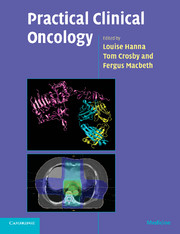Book contents
- Frontmatter
- Contents
- List of contributors
- Preface
- Acknowledgements
- Abbreviations
- 1 Practical issues in cytotoxic chemotherapy usage
- 2 Biological treatments in cancer
- 3 Hormones in cancer
- 4 Radiotherapy planning
- 5 Research in cancer
- 6 Oncological emergencies
- 7 Palliative care
- 8 Head and neck
- 9 Oesophagus
- 10 Stomach
- 11 Liver, gallbladder and biliary tract
- 12 Exocrine pancreas
- 13 Colon and rectum
- 14 Anus
- 15 Gastrointestinal stromal tumours
- 16 Breast
- 17 Kidney
- 18 Bladder
- 19 Prostate
- 20 Testis
- 21 Penis
- 22 Ovary
- 23 Body of the uterus
- 24 Cervix
- 25 Vagina
- 26 Vulva
- 27 Gestational trophoblast tumours
- 28 Lung
- 29 Mesothelioma
- 30 Soft tissue and bone tumours in adults
- 31 The lymphomas and myeloma
- 32 Central nervous system
- 33 Skin cancer other than melanoma
- 34 Melanoma
- 35 Thyroid
- 36 Neuroendocrine tumours
- 37 Cancer in children
- 38 Cancer of unknown primary
- 39 The use of radiotherapy in the treatment of benign conditions
- Multiple choice questions
- Multiple choice answers
- Index
- References
9 - Oesophagus
Published online by Cambridge University Press: 23 December 2009
- Frontmatter
- Contents
- List of contributors
- Preface
- Acknowledgements
- Abbreviations
- 1 Practical issues in cytotoxic chemotherapy usage
- 2 Biological treatments in cancer
- 3 Hormones in cancer
- 4 Radiotherapy planning
- 5 Research in cancer
- 6 Oncological emergencies
- 7 Palliative care
- 8 Head and neck
- 9 Oesophagus
- 10 Stomach
- 11 Liver, gallbladder and biliary tract
- 12 Exocrine pancreas
- 13 Colon and rectum
- 14 Anus
- 15 Gastrointestinal stromal tumours
- 16 Breast
- 17 Kidney
- 18 Bladder
- 19 Prostate
- 20 Testis
- 21 Penis
- 22 Ovary
- 23 Body of the uterus
- 24 Cervix
- 25 Vagina
- 26 Vulva
- 27 Gestational trophoblast tumours
- 28 Lung
- 29 Mesothelioma
- 30 Soft tissue and bone tumours in adults
- 31 The lymphomas and myeloma
- 32 Central nervous system
- 33 Skin cancer other than melanoma
- 34 Melanoma
- 35 Thyroid
- 36 Neuroendocrine tumours
- 37 Cancer in children
- 38 Cancer of unknown primary
- 39 The use of radiotherapy in the treatment of benign conditions
- Multiple choice questions
- Multiple choice answers
- Index
- References
Summary
Introduction
In the past few decades there has been a dramatic increase in the incidence of adenocarcinoma of the oesophagus, predominantly in the lower oesophagus and gastro-oesophageal junction. This trend has been noted across most patient populations worldwide but is most noticeable in the younger, white male population, where it would appear to be related to gastro-oesophageal reflux disease (GORD) and to be less strongly associated with alcohol and smoking. Meanwhile, the incidence of squamous cancer worldwide has remained steady or fallen slightly, though there are large geographical variations.
The majority of patients present with symptoms of locally advanced or metastatic disease, which limits survival from any treatment. Combined modality therapy is increasingly used in these cases. Chemoradiation is more effective than radiotherapy alone and there is some evidence that preoperative chemotherapy is superior to surgery alone. There is a continuing controversy about the exact role of surgery combined with chemoradiotherapy and which one should be used as the primary therapy. Clinical trials are currently trying to define the optimum radiotherapy and chemotherapy regimens.
Types of oesophageal tumour
The types of oesophageal tumours are shown in Table 9.1.
The oesophagus is a relatively common site for a second primary cancer. For instance, following successful treatment for head and neck cancer, 4% of patients per year develop a second primary, 30% of which are oesophageal, especially squamous cancers.
- Type
- Chapter
- Information
- Practical Clinical Oncology , pp. 121 - 131Publisher: Cambridge University PressPrint publication year: 2008

